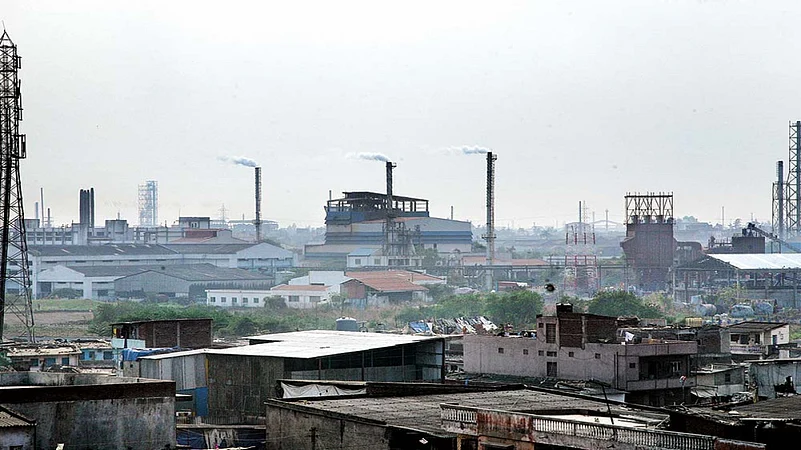It’s been 50 years since the Clean Air Act of 1970 was enacted in the United States. In that time the US has reduced its air pollution emissions by about 70%. Nevertheless, the US still doesn’t reach the World Health Organization’s annual ambient air pollution guideline limits in many locations. That is true for 91% of the earth’s population. The good news (for Americans) is that the continued outsourcing of manufacturing and service jobs both purposefully and inadvertently exports pollution and might just help the US to reach that goal sooner. The unfortunate downside for countries like India, that undoubtedly benefit from this outsourcing, is that many of the manufacturing sectors are those in the most pollution intensive industries. Undoubtedly, this is no coincidence. Corporations do knowingly export polluting operations to avoid the additional costs of pollution and emissions reducing equipment and processes.
When foreign direct investment sets up manufacturing centres and supply-chain sectors in India without insisting on the same air pollution standards required by their governments back home, they know that they are to some extent profiting from the disease, disability and death of Indian citizens. They knowingly take advantage of the misperception among some Indian policymakers and industrialists that air pollution and ecological damage are unavoidable consequences of manufacturing, chemical production, and mining. Meanwhile, the economies in all countries with more strictly enforced air quality standards and emissions controls grew rapidly over the years completely disproving the notion that air pollution controls are costly and dampen economic growth.
Much of the US’s success in pollution reduction is due to laws and enforcement of regulations by a properly funded EPA (that’s the official story). But, as an informed global citizen I can testify that much of that reduction (or rather prevention of an increase), was also achieved unintentionally by shifting manufacturing jobs to markets where the cost of both labour and doing business are less. When multinationals seek low-cost labour in China, India, and other countries they also for all intents and purposes export pollution and waste.
Fuel quality standards and emissions standards are typically far more ‘relaxed’ as policymakers and regulators in many parts of the rapidly developing world are unaware of (or willing to ignore) the real cost to both public health and economic growth due to uncontrolled air, water, and soil pollution. Many years ago, when FDI was first introduced it was not unheard of to find India-based joint-ventures importing factory technology that was obsolete and polluting (i.e., the factory tools and equipment) all bundled neatly into containers. The foreign investors knew very well they were only able to extend the product life cycle of their old investments precisely because Indian laws permitted the older technology with fewer pollution controls to operate unperturbed. This is the rare event in India today. But it was is undoubtedly the willful exportation of pollution and air pollution.
I submit the responsibility lies with both foreign and Indian policymakers. It is very unethical and even pernicious when developed nations with stricter environmental controls permit their multinational corporations to finance and create so-called “low-cost” manufacturing hubs in developing countries while ignoring the health impacts and environmental damage that occurs in the absence of the same pollution controls and processes they use back home.
The solution…
It requires international trade agreements to promote fair trade that considers the damage to the ecology and to human health. Many lower- and middle-income countries keep their emissions and environmental regulations and enforcement protections weak in order to attract foreign investment. They are told that other nations are not enforcing air pollution standards. They fear being ‘outbid’ by another country unaware or neglectful of the health and well-being of their people.
The World Trade Organization, the United Nations, the G20, and other regional trade organisations must end the willful use of these unethical practices and investments that knowingly profit from human suffering due to pollution exposure. These emissions also add risks to our economic stability and longevity due to climate change. The World Economic Forum has described the need for sustainable development to be taken seriously. But its members seemingly wait for some sign or event. Perhaps the awaited event is the coronavirus pandemic. The pandemic has taught us a lesson about our neglect of the environment and our health systems. As many as 27% of COVID-19 deaths in Asia are associated with long-term exposure to air pollution. The economic devastation of this pandemic together with this knowledge informs us of an opportunity. This is described best in the call by the WHO to build back better in its manifesto for a healthy recovery from COVID-19.
Another key requirement to accelerate rapid adoption of clean energy, materials and processes is for governments and trade organisations to recognise the role of science. International coalitions of researchers and experts can leverage science along with the ‘precautionary principle’ to guide the creation of global health- and energy-based international standards for environment and environmental health protection. Our capability to better understand which of our choices are sustainable is improving dramatically with each passing year.
We have supercomputers, interconnected datalogging devices, affordable and secure data storage, and nanotechnologies that enable us to analyse the impact of our choices of energy, chemicals, and materials. The owners of activities that we have long identified as polluting must now be required to provide ‘proof of no-harm’ before gaining approval to continue or start that activity. The status quo of requiring health and environment experts to shoulder the burden of proving harm from activities that we know involve ecological and environmental health toxins and hazards is foolish and myopic in this day and age of sustainable development goals.
The United Nations (or perhaps first the G20) can define and establish standards and goals that will reduce the health impacts of air pollution through the worldwide emissions harmonization and creation of health in all policies (HiAP) requirements to govern all imports and exports with an initial focus on:
- fuel quality standards,
- emissions standards of factories,
- emissions standards for private power generation,
- manufacturing and supply-chain processes,
- mineral extraction,
- household, restaurant, and other commercial waste management,
- landfill and municipal solid waste management,
- incineration location and controls,
- and so on.
Health is wealth
The health and well-being of everyone can be calculated. The old adage that ‘health is wealth’ is true. Healthy people are the most productive. Healthy people have the greatest opportunity to improve their lives and the lives of everyone around them.
India often compares its development trajectory with that of China. China in investing heavily in clean technology and clean energy as they recognise these new technologies will drive a new sustainable industrial revolution and circular economic growth and jobs creation that benefit health and well-being at the same time. India has catching up to do to match China’s ambitious growth plans. But, the recent announcements of India’s renewable energy goals to meet the Paris Agreement on climate could be the indication for which clean technology investors were waiting. The sooner that India acknowledges that the public health and longevity of its citizens is required for economic growth that will employ the huge underemployed and unemployed numbers of youthful Indians, the sooner Indians will enjoy happier, healthier, and more productive lives.
(Views are personal)
The author is a Geneva-based consultant with the World Health Organization on air quality monitoring and urban health projects. He lived in Delhi for 10 years till 2016.





















